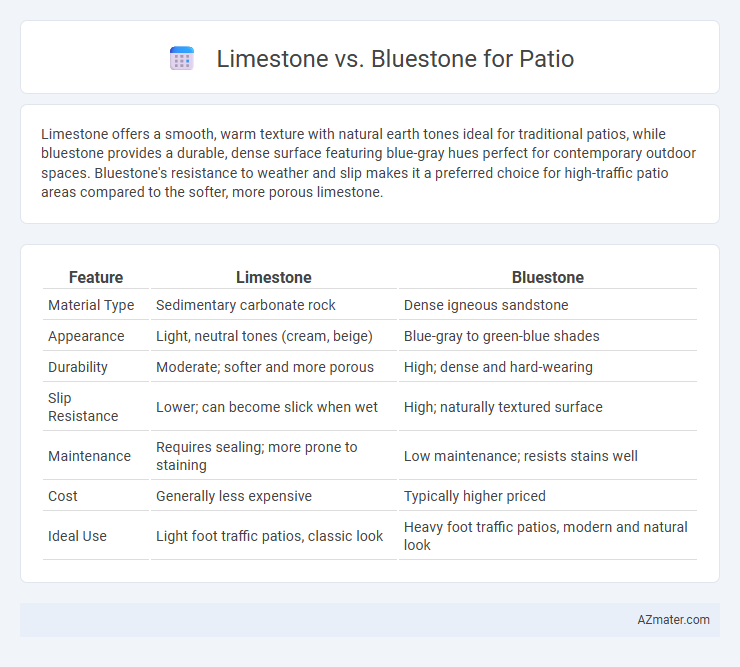Limestone offers a smooth, warm texture with natural earth tones ideal for traditional patios, while bluestone provides a durable, dense surface featuring blue-gray hues perfect for contemporary outdoor spaces. Bluestone's resistance to weather and slip makes it a preferred choice for high-traffic patio areas compared to the softer, more porous limestone.
Table of Comparison
| Feature | Limestone | Bluestone |
|---|---|---|
| Material Type | Sedimentary carbonate rock | Dense igneous sandstone |
| Appearance | Light, neutral tones (cream, beige) | Blue-gray to green-blue shades |
| Durability | Moderate; softer and more porous | High; dense and hard-wearing |
| Slip Resistance | Lower; can become slick when wet | High; naturally textured surface |
| Maintenance | Requires sealing; more prone to staining | Low maintenance; resists stains well |
| Cost | Generally less expensive | Typically higher priced |
| Ideal Use | Light foot traffic patios, classic look | Heavy foot traffic patios, modern and natural look |
Introduction to Limestone and Bluestone Patios
Limestone patios offer a natural, light-toned surface known for its smooth texture and durability, making it ideal for creating elegant outdoor spaces with a classic aesthetic. Bluestone patios feature a dense, fine-grained sandstone with rich blue-gray hues, prized for its slip-resistant properties and ability to withstand harsh weather conditions. Both materials provide versatile options for patios, with limestone emphasizing subtle warmth and bluestone delivering robust, visually striking appeal.
Key Differences Between Limestone and Bluestone
Limestone and bluestone differ primarily in composition and durability, with limestone being a sedimentary rock rich in calcium carbonate, while bluestone is a dense, fine-grained sandstone with high quartz content. Limestone typically offers a softer, warmer tone and is more prone to scratching and weathering, making it ideal for low-traffic patios, whereas bluestone provides superior strength, a smoother texture, and natural slip resistance, suited for high-traffic or outdoor environments. Color variation also distinguishes these materials, as limestone generally ranges from creamy white to beige, while bluestone features cooler blue-gray hues that bring a modern aesthetic to patio surfaces.
Appearance and Color Variations
Limestone offers a softer, more muted palette with shades ranging from creamy white to beige and subtle gray, creating a classic and elegant look for patios. Bluestone, known for its rich, dense hues, displays a variety of blues, grays, and sometimes purples, providing a striking and contemporary appearance. Both materials feature natural textures that enhance outdoor spaces, but Bluestone's vibrant colors often make it a standout choice for bold design statements.
Durability and Weather Resistance
Limestone offers moderate durability with a softer surface that may show wear and etching over time, making it less ideal for areas with heavy foot traffic or harsh weather conditions. Bluestone is highly durable, featuring a dense, non-porous structure that resists chipping, cracking, and absorbs less moisture, providing superior weather resistance in freeze-thaw cycles. For patios exposed to varying climates, bluestone's durability and resistance to moisture make it a more resilient choice compared to limestone.
Maintenance Requirements
Limestone patios require regular sealing to prevent staining and weather damage due to their porous nature, making maintenance more intensive. Bluestone is denser and less porous, resulting in lower upkeep with occasional cleaning and resealing as needed to preserve color and durability. Both materials benefit from prompt stain removal and protection from harsh chemicals to maintain their appearance over time.
Cost Comparison
Limestone patios typically range from $7 to $15 per square foot, making them a cost-effective choice for budget-conscious projects. Bluestone, known for its durability and unique blue-gray hues, generally costs between $15 and $25 per square foot, reflecting its premium quality and aesthetic appeal. Installation expenses for both materials vary based on labor rates and site preparation but tend to be higher for bluestone due to its density and weight.
Installation Process for Each Stone
Limestone installation requires a stable, level base with proper drainage to prevent water damage and often involves sealing to enhance durability and prevent staining. Bluestone installation demands a compacted sub-base of crushed stone for stability and typically uses polymeric sand between joints to minimize weed growth and shifting. Both materials benefit from professional cutting and fitting to achieve a seamless, long-lasting patio surface.
Safety and Slip Resistance
Limestone offers a naturally textured surface that enhances slip resistance, making it a safer choice for patios, especially when wet. Bluestone, while visually appealing with its smooth finish, may become slippery when exposed to moisture without proper treatment or sealing. Prioritizing materials with high slip resistance ratings and considering surface treatments can significantly improve patio safety for both limestone and bluestone.
Eco-Friendliness and Sustainability
Limestone and bluestone both offer eco-friendly options for patios, but limestone is often favored for its natural formation with minimal chemical processing, reducing environmental impact. Bluestone, primarily quarried in the northeastern United States, supports local economies and typically requires less transportation-related emissions when sourced regionally. Both materials are durable and long-lasting, lowering the need for frequent replacements and contributing to sustainable landscaping choices.
Which Stone Is Best for Your Patio?
Limestone offers a smooth, warm texture and is highly durable, making it ideal for patios in moderate climates, while bluestone provides a dense, slip-resistant surface with rich blue-gray hues perfect for outdoor areas prone to moisture. Bluestone's superior hardness and resistance to weathering make it a popular choice for long-lasting patios, whereas limestone requires more maintenance but delivers a classic, elegant appearance. Choosing the best stone depends on your climate, desired aesthetic, and maintenance commitment for a durable and visually appealing patio.

Infographic: Limestone vs Bluestone for Patio
 azmater.com
azmater.com